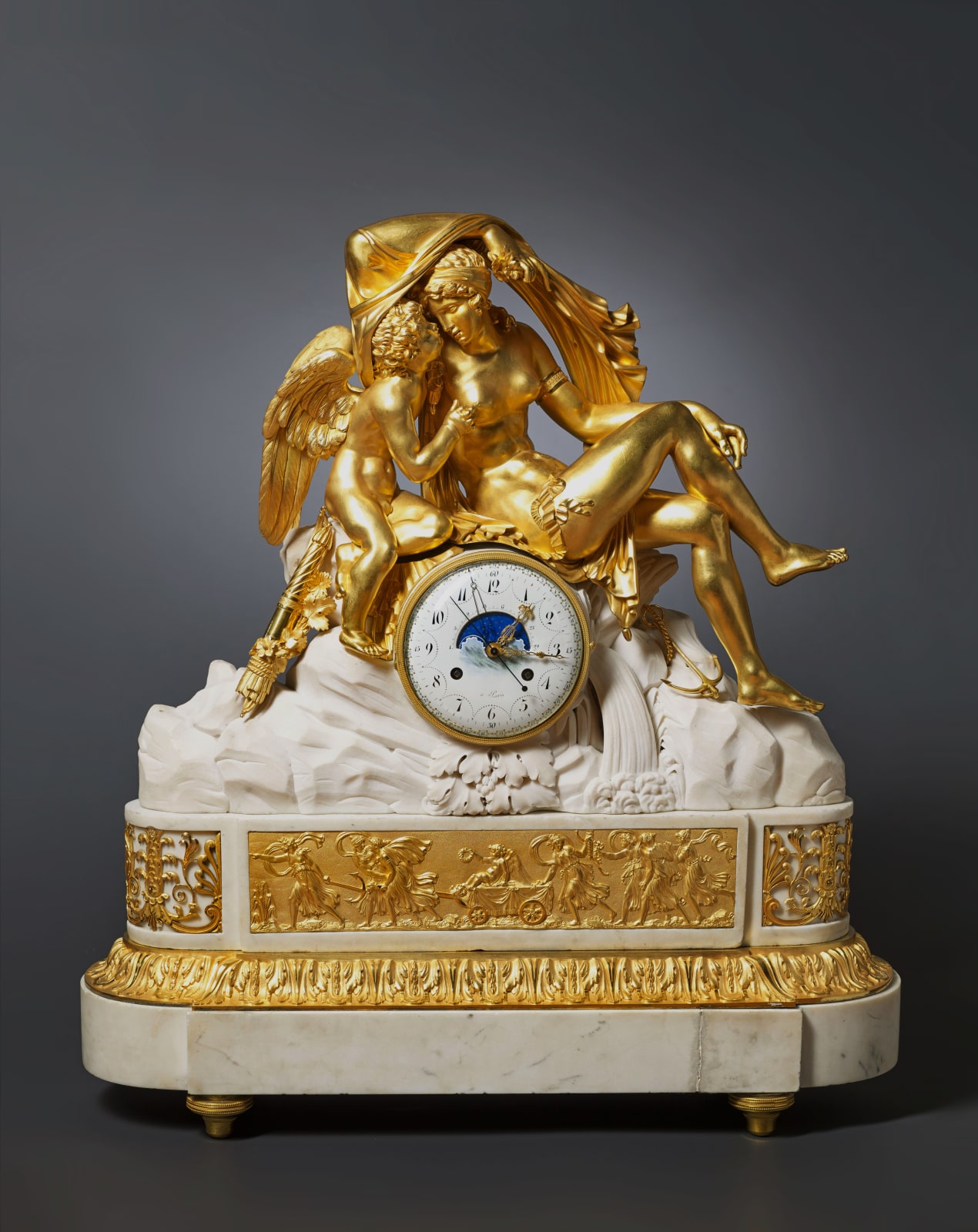Josep Coteau or Etienne Gobin (attributed to)
A rare, large and extremely fine Louis XVI gilt bronze and white marble mantel clock of fourteen days duration signed à Paris on the gilt and polychrome painted white enamel dial. The magnificent dial attributed to either Joseph Coteau or Etienne Gobin, known as Dubuisson with Arabic numerals for the minute and hour chapter rings, the latter ornamented by gilt beaded swags, with an outer calendar ring for the 31 days of the month with each numeral set within a gilt painted lozenge decorated with green and red beads, the dial centred by a superb blue and gilt star-studded moon phase with upper markings for the 29 ½ days in the lunar month, with an exceptionally fine pair of pierced lyre-shaped gilt brass hands for the hours and minutes, the minute hand with a sun burst, a blued steel pointer for the sweep centre seconds and blued steel hand for the calendar indications. The circular brass movement with going barrels for the going and the striking trains, pin wheel escapement on the back plate, knife edge suspension and a half seconds beating pendulum, striking on the hours and half hours.
The superb case surmounted by the gilt bronze figures of Venus and Cupid, with Venus to the right half reclining, holding swirling drapery that enfolds her and Cupid and falls down between her thighs to cover her nudity, wearing a garter around her right thigh, arms bands and a hair band, she holds a bunch of flowers in her uplifted right hand while looking down toward the standing winged Cupid who places a finger on her breast while kneeling on her drapery that falls around the top of dial bezel, with a gilt bow and quiver of arrows beside Cupid’s feet and a gilt anchor beside Venus, the dial set within white marble which is carved to resemble rock with a fountain of water issuing below Venus and oak leaves below the dial, the whole placed on a shaped rectangular white marble plinth with bow ends mounted with a panel of anthemion and acanthus palmettes and centred by a gilded frieze featuring Cupid seated on a chariot, drawn and followed by Muses, the stepped white marble base mounted with a gilt bronze acanthus band, supported on four turned feet
Paris, circa 1790
Height 90 cm, width 84 cm, depth 24 cm.
This magnificent late eighteenth century clock is almost certainly unique for it is not only much larger than others of the period but the arrangement of Venus and Cupid does not compare with any other known figural clocks. One can also assume that it was made as a special commission owing to its monumentality, the supreme quality of the bronzes and sculptured marble, its exquisite painted dial, combined with the complexity of the movement to include astronomical indications. Moreover, because the subject of the case revolves around the theme of love and portrays Venus and Cupid in such an intimate manner, it is very likely that this clock was intended as a gift from a wealthy aristocrat or royal member to his wife or lover.
Another interesting aspect is that although the clock has a complex movement and boasts an extremely high quality dial there is no mention of the clockmaker’s name on the dial. Instead it is simply signed ‘à Paris’ which implies that it was made during the years of the French Revolution when clockmakers were loathed to advertise their name, owing to their former association with royalty or the aristocracy, who were the only ones who could afford these luxury items. It is also likely that the dial (which was the last part of the clock to be completed) was painted sometime after 1789, when the Revolution began and before 1793, at which date a new Republican time system was introduced. This new decimal system stipulated that the months should be divided into 30 rather than 31 days, the days into ten hours and hours into 100 minutes. Although not all clocks showed this new Republican time system (which was later abandoned in favour of the old Gregorian system), most clocks of this period displayed 30 as opposed to 31 days within the calendar ring. Since the dial displays 31 days in the month we can assume that the clock was completed sometime between 1789 and 1793.
Despite the lack of a name on the dial it can be assured that the movement was made by one of the leading Parisian clockmakers. Likewise, the style and sheer quality of the dial itself to include gilt and polychrome painted decorations and an exceptionally fine moon phase, could only have been painted by either Etienne Gobin, known as Dubuisson (b. 1731 d. after 1815) or Joseph Coteau (1740-1812), who was the two leading enamellist painters at this period.
The beauty of the dial is matched by the exquisite case crowned by Venus and Cupid as symbols of love. As a subject Venus and Cupid was a common theme of late eighteenth century French figural clocks. However very few show the young Cupid and the mythological goddess of love in such a sensual manner. More commonly there is a distinct division between the two in which Venus is shown teasing, nurturing or instructing Cupid. In contrast their intimate pose here relates more closely to paintings in which European artists from the Renaissance onward emphasised the sensual nature of love, for instance in Titian’s Venus and Cupid (c. 1550; Uffizi Gallery, Florence) or Alessandro Allori’s Venus and Cupid (post 1570; Musée Fabre, Montpellier) where the reclining Venus is very closely attended to by Cupid. The same theme of such earthly love was repeated by artists in the following centuries not least by Sir Joshua Reynolds in his Cupid Untying the Zone of Venus (1788; The Hermitage, St. Petersburg). The theme of love is further emphasised by the inclusion of Cupid’s bow and arrows, the posy of flowers held by Venus as well as the anchor to symbolise love’s hold. Likewise, love is sometimes symbolised by a fountain (which here gushes from the rock below Venus) in the Garden of Love or Arcadia while the oak leaves below the dial can be read as a symbol of durability and constancy.
Another popular subject for Neo-classical clock case were the two lovers Cupid and Psyche, however in those instances Cupid was a young adult while here he is still a small child. In many respects the figure of Venus can be likened to that of the mythological figure Erigone who lies in abandon surmounting a clock case of the same date, made by the esteemed fondeur-ciseleur Pierre-Philippe Thomire (1751-1843). Housing a movement by Laguesse à Paris, the clock was acquired by Tsar Paul I for the Palace of St. Michel and is now at Pavlovsk Palace, St. Petersburg while another version with movement by Jean-Antoine Lépine was sold by this gallery. One can also compare Venus’s pose with that of an antique statue of Cleopatra, believed to represent the sleeping Ariadne (2nd c. BC; Vatican Museum, Rome) which inspired numerous artists and was made the subject of a clock case by the bronzier André-Antoine Ravrio (1759-1814), of which two versions have been sold by this gallery. What underlies those and this clock is the sheer beauty of the female form and how well it lends itself as a subject for a clock case.



